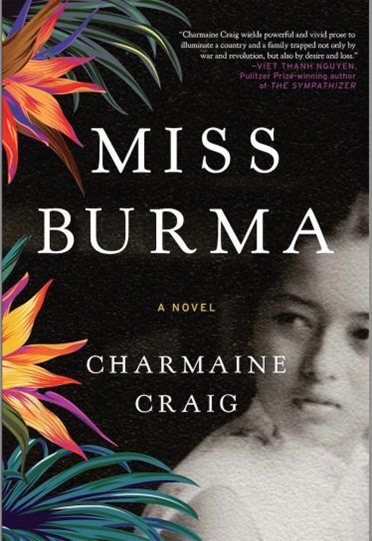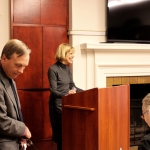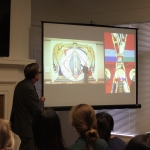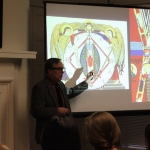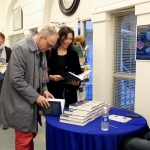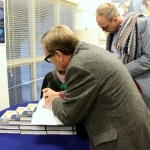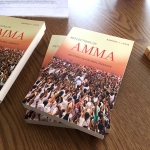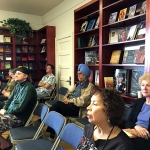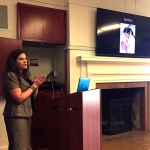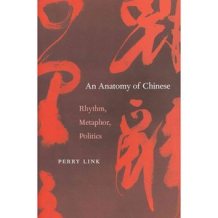Emory Elliott Book Awards
 Made possible by gifts from Emory’s family and friends, the Emory Elliott Book Award honors the book published by a CHASS faculty member during the previous academic year that, in the judgment of the selection committee, best exemplifies the values that characterized Professor Elliott and his contributions to life and letters.
Made possible by gifts from Emory’s family and friends, the Emory Elliott Book Award honors the book published by a CHASS faculty member during the previous academic year that, in the judgment of the selection committee, best exemplifies the values that characterized Professor Elliott and his contributions to life and letters.
Among these many contributions are the capacity to recognize complexity together with the passion to clarify, the ability to contribute to a conversation rather than to summarize agreements already established, and the intent to further a tradition of creative and scholarly munificence.
Charmaine Craig (Creative Writing)
Miss Burma
A beautiful and poignant story of one family during the most violent and turbulent years of world history, Miss Burma is a powerful novel of love and war, colonialism and ethnicity, and the ties of blood. Based on the story of the author’s mother and grandparents, Miss Burma is a captivating portrait of how modern Burma came to be and of the ordinary people swept up in the struggle for self-determination and freedom.
Miss Burma tells the story of modern-day Burma through the eyes of Benny and Khin, husband and wife, and their daughter Louisa. After attending school in Calcutta, Benny settles in Rangoon, then part of the British Empire, and falls in love with Khin, a woman who is part of a long-persecuted ethnic minority group, the Karen. World War II comes to Southeast Asia, and Benny and Khin must go into hiding in the eastern part of the country during the Japanese Occupation, beginning a journey that will lead them to change the country’s history. After the war, the British authorities make a deal with the Burman nationalists, led by Aung San, whose party gains control of the country. When Aung San is assassinated, his successor ignores the pleas for self-government of the Karen people and other ethnic groups, and in doing so sets off what will become the longest-running civil war in recorded history. Benny and Khin’s eldest child, Louisa, has a danger-filled, tempestuous childhood and reaches prominence as Burma’s first beauty queen soon before the country falls to dictatorship. As Louisa navigates her newfound fame, she is forced to reckon with her family’s past, the West’s ongoing covert dealings in her country, and her own loyalty to the cause of the Karen people.
**New York Times Book Review Editors’ Choice; Amazon Best Book of the Month (Literature & Fiction); Long-listed for the 2017 National Book Award for Fiction; Library Journal Notable Book for 2017; An Indie Next Selection.**
Anthea Kraut (Dance)
Choreographing Copyright: Race Gender, and Intellectual Property Rights in American Dance
 Choreographing Copyright is a new historical and cultural analysis of U.S. dance-makers’ investment in intellectual property rights. Stretching from the late nineteenth century to the early twenty-first, the book reconstructs efforts to win copyright protection for choreography and teases out their raced and gendered politics, showing how dancers have embraced intellectual property rights as a means to both consolidate and contest racial and gendered power. A number of the artists featured in the book are well-known in the history of American dance, including Loie Fuller, Hanya Holm, and Martha Graham, Agnes de Mille, and George Balanchine. But the book also uncovers a host of marginalized figures–from the South Asian dancer Mohammed Ismail, to the African American pantomimist Johnny Hudgins, to the African American blues singer Alberta Hunter, to the white burlesque dancer Faith Dane–who were equally interested in positioning themselves as subjects rather than objects of property. Drawing on critical race and feminist theories and on cultural studies of copyright, Choreographing Copyright offers fresh insight into the raced and gendered hierarchies that govern the theatrical marketplace, white women’s historically contingent relationship to property rights, legacies of ownership of black bodies and appropriation of non-white labor, and the tension between dance’s ephemerality and its reproducibility.
Choreographing Copyright is a new historical and cultural analysis of U.S. dance-makers’ investment in intellectual property rights. Stretching from the late nineteenth century to the early twenty-first, the book reconstructs efforts to win copyright protection for choreography and teases out their raced and gendered politics, showing how dancers have embraced intellectual property rights as a means to both consolidate and contest racial and gendered power. A number of the artists featured in the book are well-known in the history of American dance, including Loie Fuller, Hanya Holm, and Martha Graham, Agnes de Mille, and George Balanchine. But the book also uncovers a host of marginalized figures–from the South Asian dancer Mohammed Ismail, to the African American pantomimist Johnny Hudgins, to the African American blues singer Alberta Hunter, to the white burlesque dancer Faith Dane–who were equally interested in positioning themselves as subjects rather than objects of property. Drawing on critical race and feminist theories and on cultural studies of copyright, Choreographing Copyright offers fresh insight into the raced and gendered hierarchies that govern the theatrical marketplace, white women’s historically contingent relationship to property rights, legacies of ownership of black bodies and appropriation of non-white labor, and the tension between dance’s ephemerality and its reproducibility.
Conrad Rudolph (Art History)
The Mystic Ark: Hugh of Saint Victor, Art, and Thought in the Twelfth Century
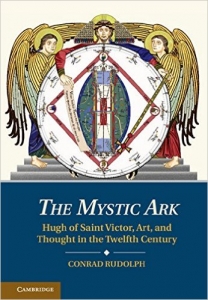 Because of the absolute fundamentality of the concept of creation (both the cause of existence and material creation in general), any given culture’s view of creation is crucial to that culture’s intellectual self-identity. This was never more the case than in the twelfth century, a time when the Church’s monopoly on learning was being seriously threatened by an ever widening interest in platonic creation theory. In The Mystic Ark (c. 1125)–an image of all space, all time, all matter, all human history, and all spiritual striving, and perhaps the most complex single work of art from the entire Middle Ages–the great Parisian scholar Hugh of Saint Victor addressed creation theory in a way that had never been done before, a way as complex as the painting itself. In so doing, The Mystic Ark rose above its immediate character as a pedagogical image and–as a visualization of the politics of theology–became an active agent both in the shaping of the new intellectual elite and in the polemical discourses of one of the great “transitional” periods of Western history.
Because of the absolute fundamentality of the concept of creation (both the cause of existence and material creation in general), any given culture’s view of creation is crucial to that culture’s intellectual self-identity. This was never more the case than in the twelfth century, a time when the Church’s monopoly on learning was being seriously threatened by an ever widening interest in platonic creation theory. In The Mystic Ark (c. 1125)–an image of all space, all time, all matter, all human history, and all spiritual striving, and perhaps the most complex single work of art from the entire Middle Ages–the great Parisian scholar Hugh of Saint Victor addressed creation theory in a way that had never been done before, a way as complex as the painting itself. In so doing, The Mystic Ark rose above its immediate character as a pedagogical image and–as a visualization of the politics of theology–became an active agent both in the shaping of the new intellectual elite and in the polemical discourses of one of the great “transitional” periods of Western history.
January 7, 2016 – Reception & Book Talk
Amanda J. Lucia (Religious Studies)
Reflections of Amma: Devotees in a Global Embrace
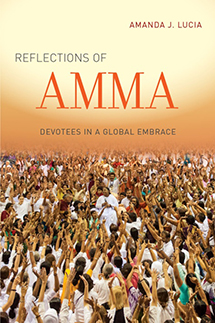 Globally known as Amma, meaning “Mother,” Mata Amritanandamayi has developed a massive transnational humanitarian organization based in hugs. She is familiar to millions as the “hugging saint,” a moniker that derives from her elaborate darshan programs wherein nearly every day ten thousand people are embraced by the guru one at a time, events that routinely last ten to twenty hours without any rest for her. Although she was born in 1953 as a low-caste girl in a South Indian fishing village, today millions revere her as guru and goddess, a living embodiment of the divine on earth.
Globally known as Amma, meaning “Mother,” Mata Amritanandamayi has developed a massive transnational humanitarian organization based in hugs. She is familiar to millions as the “hugging saint,” a moniker that derives from her elaborate darshan programs wherein nearly every day ten thousand people are embraced by the guru one at a time, events that routinely last ten to twenty hours without any rest for her. Although she was born in 1953 as a low-caste girl in a South Indian fishing village, today millions revere her as guru and goddess, a living embodiment of the divine on earth.
Reflections of Amma focuses on communities of Amma’s devotees in the United States, showing how they endeavor to mirror their guru’s behaviors and transform themselves to emulate the ethos of the movement. This study argues that “inheritors” and “adopters” of Hindu traditions differently interpret Hindu goddesses, Amma, and her relation to feminism and women’s empowerment because of their inherited religious, cultural, and political dispositions. In this insightful ethnographic analysis, Amanda J. Lucia discovers how the politics of American multiculturalism reifies these cultural differences in “de facto congregations,” despite the fact that Amma’s embrace attempts to erase communal boundaries in favor of global unity.
February 3, 2015 – Reception and Talk
Maudemarie Clark (Philosophy)
The Soul of Nietzsche’s Beyond Good and Evil
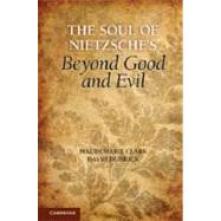 This book presents a provocative new interpretation of Beyond Good and Evil, arguably Nietzsche’s most important work. The problem is that it appears to express merely a loosely connected set of often questionable opinions. Can Nietzsche really be an important philosopher if this is his most important book? Maudemarie Clark and David Dudrick address this question with a close reading that emphasizes how Nietzsche writes. They argue that the first part of Beyond Good and Evil presents coherent and interconnected arguments for subtle and well-thought-out positions on traditional issues. Nietzsche’s infamous doctrine of the will to power turns out to be a compelling account of the structure and origin of the human soul. And although he rejects some aspects of traditional philosophy, Nietzsche’s aim is to show how philosophy’s traditional aspirations to seek both the true and the good can be fulfilled. Beyond Good and Evil turns out to be a major work of philosophy and Nietzsche’s masterpiece.
This book presents a provocative new interpretation of Beyond Good and Evil, arguably Nietzsche’s most important work. The problem is that it appears to express merely a loosely connected set of often questionable opinions. Can Nietzsche really be an important philosopher if this is his most important book? Maudemarie Clark and David Dudrick address this question with a close reading that emphasizes how Nietzsche writes. They argue that the first part of Beyond Good and Evil presents coherent and interconnected arguments for subtle and well-thought-out positions on traditional issues. Nietzsche’s infamous doctrine of the will to power turns out to be a compelling account of the structure and origin of the human soul. And although he rejects some aspects of traditional philosophy, Nietzsche’s aim is to show how philosophy’s traditional aspirations to seek both the true and the good can be fulfilled. Beyond Good and Evil turns out to be a major work of philosophy and Nietzsche’s masterpiece.
Perry Link (Comparative Literature)
An Anatomy of Chinese: Rhythm, Metaphor, Politics
During the Cultural Revolution, Mao exhorted the Chinese people to “smash the four olds”: old customs, old culture, old habits, and old ideas. Yet when the Red Guards in Tiananmen Square chanted “We want to see Chairman Mao,” they unknowingly used a classical rhythm that dates back to the Han period and is the very embodiment of the four olds. An Anatomy of Chinese reveals how rhythms, conceptual metaphors, and political language convey time-honored meanings of which Chinese speakers themselves may not be consciously aware, and contributes to the ongoing debate over whether language shapes thought, or vice versa.
Perry Link’s inquiry into the workings of Chinese reveals convergences and divergences with English, most strikingly in the area of conceptual metaphor. Different spatial metaphors for consciousness, for instance, mean that English speakers wake up while speakers of Chinese wake across. Other underlying metaphors in the two languages are similar, lending support to theories that locate the origins of language in the brain. The distinction between daily-life language and official language has been unusually significant in contemporary China, and Link explores how ordinary citizens learn to play language games, artfully wielding officialese to advance their interests or defend themselves from others.
Particularly provocative is Link’s consideration of how Indo-European languages, with their preference for abstract nouns, generate philosophical puzzles that Chinese, with its preference for verbs, avoids. The mind-body problem that has plagued Western culture may be fundamentally less problematic for speakers of Chinese.
Priya Srinivasan (Dance)
Sweating Saris: Indian Dance as Transnational Labor
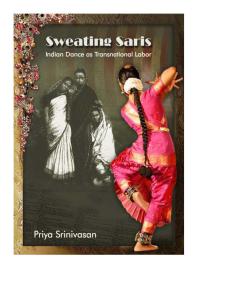 A groundbreaking book that seeks to understand dance as labor, Sweating Saris examines dancers not just as aesthetic bodies but as transnational migrant workers and wage earners who negotiate citizenship and gender issues.
A groundbreaking book that seeks to understand dance as labor, Sweating Saris examines dancers not just as aesthetic bodies but as transnational migrant workers and wage earners who negotiate citizenship and gender issues.
Srinivasan merges ethnography, history, critical race theory, performance and post-colonial studies among other disciplines to investigate the embodied experience of Indian dance. The dancers’ sweat stained and soaked saris, the aching limbs are emblematic of global circulations of labor, bodies, capital, and industrial goods. Thus the sweating sari of the dancer stands in for her unrecognized labor.
Srinivasan shifts away from the usual emphasis on Indian women dancers as culture bearers of the Indian nation. She asks us to reframe the movements of late nineteenth century transnational Nautch Indian dancers to the foremother of modern dance Ruth St. Denis in the early twentieth century to contemporary teenage dancers in Southern California, proposing a transformative theory of dance, gendered-labor, and citizenship that is far-reaching.
Michelle Raheja (English)
Reservation Reelism: Redfacing, Visual Sovereignty, and Representations of Native Americans in Film
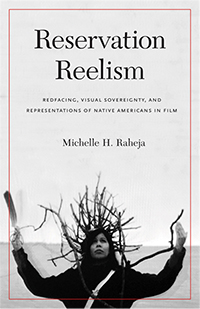 In this engaging account, Michelle H. Raheja offers the first book-length study of the Indigenous actors, directors, and spectators who not only helped shape Hollywood’s representation of Indigenous peoples but also, through their very participation, complicated the dominant, and usually negative, messages about Native peoples in film. Since the era of silent films, Hollywood movies and visual culture generally have provided the primary representational field on which Indigenous images have been displayed to non-Native audiences. As such, these films have been highly influential in shaping perceptions of Indigenous peoples as, for example, a dying race or inherently unable or unwilling to adapt to change. Films with genuinely Indigenous plots and subplots, however, clearly attest a different aspect of Native presence in a culture that largely defines Native peoples as invisible or separate.
In this engaging account, Michelle H. Raheja offers the first book-length study of the Indigenous actors, directors, and spectators who not only helped shape Hollywood’s representation of Indigenous peoples but also, through their very participation, complicated the dominant, and usually negative, messages about Native peoples in film. Since the era of silent films, Hollywood movies and visual culture generally have provided the primary representational field on which Indigenous images have been displayed to non-Native audiences. As such, these films have been highly influential in shaping perceptions of Indigenous peoples as, for example, a dying race or inherently unable or unwilling to adapt to change. Films with genuinely Indigenous plots and subplots, however, clearly attest a different aspect of Native presence in a culture that largely defines Native peoples as invisible or separate.
In Reservation Reelism, Raheja traces positive representations in film that reflect the complex and vibrant experiences of Native peoples and communities.
